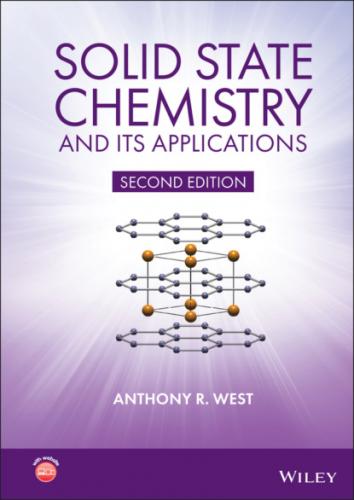Crystal Viewer
CrystalViewer is a visualisation program for displaying and manipulating crystal structures. The CrystalViewer software facilitates the exploration of crystal structures from the book in three dimensions, allowing users to view the structures in different orientations, and highlight/hide different structural features so as to aid the interpretation of complex crystal structures. The CrystalViewer program is accompanied by over 100 crystal structure files; many of these structures relate directly to illustrations from the book, identified by their figure numbers, and a variety of additional structures are provided to complement the concepts and applications discussed in the text.
The CrystalViewer software and accompanying structure files can be downloaded from the companion website at http://www.wiley.com/go/west/solidstatechemistrystudent.
An example of how a crystal structure can appear very different, depending on which aspects are emphasised, is shown here for CaCu3Ti4O12, in which the two diagrams highlight either the TiO6 octahedra or the CuO4 square planar units.
Crystal Structure Library
A Crystal Structure Library is available on the companion website containing >100 structures which can be examined in detail using the CrystalViewer Software. The structures which correspond directly to figures in the book are listed below, with the relevant figure number noted in parentheses. Many more crystal structures are available online, including minerals and other inorganic structures. Further structures may be added from time to time.
Major Inorganic Structure Types (and relevant book diagrams)
| β‐alumina, NaAl11O17 (8.23 and 8.24) Anatase BaTiO3 (8.40) bcc metal (2.12) Beryl Bi4V2O11 Bixbyite Brass, ZnCu (2.11) Brookite Brownmillerite, Ca2(Fe,Al)2O5 (1.42) Brucite CaC2 (1.10) CaCu3Ti4O12 (1.42) Calcite Ca silicates (several) CdCl2 (1.40) Cdl2 (1.39) Chevrel Phase, BaMo6S8 (8.6) Corundum, α‐Al2O3 (1.46) CsCl (1.36) Delafossite Diamond (1.33) Eucryptite fcc metal (1.20) Feldspar Fluorite/antifluorite, CaF2 (1.29, 1.30 and 1.34) Garnet, Y3Fe5O12 (1.49) GdFeO3 (1.41) Gehlenite hcp metal (1.21) Hollandite (8.27) Ilmenite, FeTiO3 (1.46) K2NiF4 (1.50) LaB6 Layered double hydroxides (4.11) | Li3N (8.32) Li2MnO3 LiCoO2/α‐NaFeO2 (8.35) LiNbO3 (1.46) Li3PO4 Li3SbO4 Li silicates LiAlO2 Magnetoplumbite (9.14) MgB2 (1.51) Mayenite Nasicon, NaZr2(PO4)3 (8.27) Melilite Mullite Muscovite Nickel arsenide, NiAs (1.35) Olivine, LiFePO4 (1.45) PbFCl, matlockite (8.6) PbO (3.14) Perovskite, SrTiO3 (1.41) Pyrochlore (1.48) Rock salt, NaCl (1.2, 1.29 and 1.31) Rutile, TiO2 (1.37) Scheelite SiO2 Sodalite Spinel (1.44) Spodumene Talc Tenorite, CuO Tetragonal tungsten bronze (1.43) Willemite Wurtzite, ZnS (1.35) YBa2Cu3O6 (8.8) YBa2Cu3O7 (8.8) Zinc blende/sphalerite, ZnS (1.29 and 1.33) Zircon ZrCuSiAs (8.6) |
Biography
Tony West obtained his BSc degree in Chemistry at University College Swansea and his PhD at the University of Aberdeen, where he worked with Professor F. P. Glasser on silicate chemistry. He was appointed as a Lecturer in Aberdeen in 1971 and developed a lifetime interest in the then‐emerging field of solid state chemistry with special interest in the synthesis of new oxide materials, their crystal structures and electrical properties. He was awarded a DSc from Aberdeen in 1984 and rose through the ranks to become Professor of Chemistry in 1989 before moving to the University of Sheffield, Department of Materials Science and Engineering, as Head of Department in 1999, a post he held until 2007.
Tony was founding editor of the Journal of Materials Chemistry and subsequently established the Materials Chemistry Forum, which has now become the Materials Chemistry Division of the Royal Society of Chemistry. He organised the First International Conference on Materials Chemistry, MCI, in Aberdeen, 1993, and coorganised the first Materials Discussion, MDI, in Bordeaux, 1998. He also served as President of the Inorganic Chemistry Division of IUPAC, 2004–2007.
Tony is a Fellow of the Royal Society of Chemistry, the Institute of Physics, the Institute of Materials, Minerals and Mining (IOM3), and the Royal Society of Edinburgh. Over the years he has received several awards, including an Industrial Award in Solid State Chemistry from the RSC (1996), the Griffiths Medal and Prize from the IOM3 (2008), the Epsilon de Oro Award from the Spanish Society of Glass and Ceramics (2007) and the Chemical Record Lectureship from the Chemical Societies of Japan (2007). He has been awarded the 2013 John B. Goodenough Award in Materials Chemistry by the RSC, a lifetime award which recognises exceptional and sustained contributions to the field of materials chemistry.
Solid State Chemistry, an Overview of the Discipline: Chemistry – Solid State Chemistry – Materials Chemistry – Materials Science and Engineering
Chemistry is an evolving subject! Traditionally, there have been three branches of chemistry: organic, physical and inorganic, with some arguments in favour of including analytical as a fourth branch. An alternative, fairly new classification (favoured by the author!) divides chemistry into two broad areas: molecular (which includes liquids and gases) and non‐molecular (or solid state). The ways in which we think about, make, analyse and use molecular and non‐molecular substances are completely different, as shown by a comparison of one ‘simple’ substance in each category, toluene and aluminium oxide:
Comparison of the chemistries of molecular and non‐molecular materials
| Characteristic | Toluene | Aluminium oxide |
|---|---|---|
| Formula | Fixed, C6H5CH3 | Usually fixed, Al2O3, but for other oxides may be variable, e.g. Fe1−x O |
| Are defects present? | Not allowed: missing or mis‐placed atoms give rise to different molecules | Unavoidable: small concentration of vacancies, interstitials and dislocations are always present |
| Doping possibilities | Not possible without producing a different molecule | Doping or solid solution formation allows control and optimisation of properties, e.g. ruby is Cr‐doped Al2O3 |
| Structure and its determination | Molecular structure can be determined spectroscopically: NMR/Mass Spec/IR. Determine packing arrangement, bond lengths and angles, by single crystal X‐ray diffraction. Usually, structural information is then complete. |
Full characterisation of a solid requires
|
